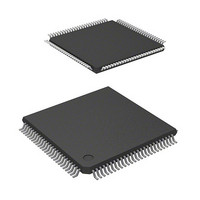DF2148BTE20 Renesas Electronics America, DF2148BTE20 Datasheet - Page 443

DF2148BTE20
Manufacturer Part Number
DF2148BTE20
Description
IC H8S MCU FLASH 128K 100-QFP
Manufacturer
Renesas Electronics America
Series
H8® H8S/2100r
Specifications of DF2148BTE20
Core Processor
H8S/2000
Core Size
16-Bit
Speed
20MHz
Connectivity
I²C, IrDA, SCI, X-Bus
Peripherals
PWM, WDT
Number Of I /o
74
Program Memory Size
128KB (128K x 8)
Program Memory Type
FLASH
Ram Size
4K x 8
Voltage - Supply (vcc/vdd)
4.5 V ~ 5.5 V
Data Converters
A/D 8x10b; D/A 2x8b
Oscillator Type
Internal
Operating Temperature
-20°C ~ 75°C
Package / Case
100-TQFP, 100-VQFP
Lead Free Status / RoHS Status
Contains lead / RoHS non-compliant
Eeprom Size
-
Other names
HD64F2148BTE20
HD64F2148BTE20
HD64F2148BTE20
Available stocks
Company
Part Number
Manufacturer
Quantity
Price
Company:
Part Number:
DF2148BTE20V
Manufacturer:
Renesas Electronics America
Quantity:
10 000
- Current page: 443 of 847
- Download datasheet (5Mb)
Section 15 Serial Communication Interface (SCI and IrDA)
15.5
Multiprocessor Communication Function
Use of the multiprocessor communication function enables data transfer to be performed among a
number of processors sharing communication lines by means of asynchronous serial
communication using the multiprocessor format, in which a multiprocessor bit is added to the
transfer data. When multiprocessor communication is carried out, each receiving station is
addressed by a unique ID code. The serial communication cycle consists of two component cycles:
an ID transmission cycle which specifies the receiving station, and a data transmission cycle for
the specified receiving station. The multiprocessor bit is used to differentiate between the ID
transmission cycle and the data transmission cycle. If the multiprocessor bit is 1, the cycle is an ID
transmission cycle, and if the multiprocessor bit is 0, the cycle is a data transmission cycle. Figure
15.10 shows an example of inter-processor communication using the multiprocessor format. The
transmitting station first sends the ID code of the receiving station with which it wants to perform
serial communication as data with a 1 multiprocessor bit added. It then sends transmit data as data
with a 0 multiprocessor bit added. The receiving station skips data until data with a 1
multiprocessor bit is sent. When data with a 1 multiprocessor bit is received, the receiving station
compares that data with its own ID. The station whose ID matches then receives the data sent next.
Stations whose ID does not match continue to skip data until data with a 1 multiprocessor bit is
again received.
The SCI uses the MPIE bit in SCR to implement this function. When the MPIE bit is set to 1,
transfer of receive data from RSR to RDR, error flag detection, and setting the SSR status flags,
RDRF, FER, and ORER in SSR to 1 are prohibited until data with a 1 multiprocessor bit is
received. On reception of a receive character with a 1 multiprocessor bit, the MPB bit in SSR is set
to 1 and the MPIE bit is automatically cleared, thus normal reception is resumed. If the RIE bit in
SCR is set to 1 at this time, an RXI interrupt is generated.
When the multiprocessor format is selected, the parity bit setting is invalid. All other bit settings
are the same as those in normal asynchronous mode. The clock used for multiprocessor
communication is the same as that in normal asynchronous mode.
Rev. 3.00 Mar 21, 2006 page 387 of 788
REJ09B0300-0300
Related parts for DF2148BTE20
Image
Part Number
Description
Manufacturer
Datasheet
Request
R

Part Number:
Description:
0.6mm Pitch Board-to-Fine-Coaxial Cable Connectors
Manufacturer:
Hirose Electric
Datasheet:

Part Number:
Description:
0.6mm Pitch Board-to-fine-coaxial Cable Connectors
Manufacturer:
Hirose Electric
Datasheet:

Part Number:
Description:
0.6mm Pitch Board-to-fine-coaxial Cable Connectors
Manufacturer:
Hirose Electric
Datasheet:

Part Number:
Description:
Right angle, Two-piece for fine coaxial cable, Discrete wire connectors; HRS No: 687-0001-5 56; No. of Positions: 20; Connector Type: Board mounting; Contact Gender: Female; Contact Spacing (mm): 0.6; Terminal Pitch (mm): 0.6; PCB Mount Type: SMT; Cu
Manufacturer:
Hirose Electric

Part Number:
Description:
0.6mm Pitch Board-to-fine-coaxial Cable Connectors
Manufacturer:
Hirose Electric
Datasheet:

Part Number:
Description:
0.6mm Pitch Board-to-Fine-Coaxial Cable Connectors
Manufacturer:
HIROSE [Hirose Electric]
Datasheet:

Part Number:
Description:
KIT STARTER FOR M16C/29
Manufacturer:
Renesas Electronics America
Datasheet:

Part Number:
Description:
KIT STARTER FOR R8C/2D
Manufacturer:
Renesas Electronics America
Datasheet:

Part Number:
Description:
R0K33062P STARTER KIT
Manufacturer:
Renesas Electronics America
Datasheet:

Part Number:
Description:
KIT STARTER FOR R8C/23 E8A
Manufacturer:
Renesas Electronics America
Datasheet:

Part Number:
Description:
KIT STARTER FOR R8C/25
Manufacturer:
Renesas Electronics America
Datasheet:

Part Number:
Description:
KIT STARTER H8S2456 SHARPE DSPLY
Manufacturer:
Renesas Electronics America
Datasheet:

Part Number:
Description:
KIT STARTER FOR R8C38C
Manufacturer:
Renesas Electronics America
Datasheet:

Part Number:
Description:
KIT STARTER FOR R8C35C
Manufacturer:
Renesas Electronics America
Datasheet:

Part Number:
Description:
KIT STARTER FOR R8CL3AC+LCD APPS
Manufacturer:
Renesas Electronics America
Datasheet:











